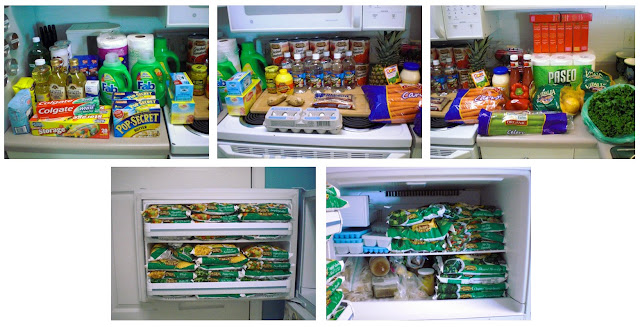As many of you know, we’ve designated the last week of every month as our No Spend Week and July is our No Spend Month in honor of celebrating Independence Day. During this time no funds are spent, with gas and living expenses (rent, electricity, phone, etc) being the only exceptions. As a result of meal planning and keeping a well stocked pantry, we previously did not include food in that exception list, but after couponing and seeing the savings deals that come abundant in July, we've decided to include food as one of the exceptions. Having a No Spend Week and Month is a way of stepping back to break free from mindless spending habits and encourages the concept of saving.
Every time the topic of our no spending period pops up, the same questions are asked..."How can you do that during times when a gift is needed?" We've done it by revamping our gift-giving and establishing a Gift Closet - a great concept started by my Grandmother that encourages abundant thinking. She was the queen of preparation and had a magic spot in her home where gift giving goodies were squirreled away.
Grandmother was a busy gal who worked full-time, volunteered extensively and had a massive social life (which included going back to college to get her degree in her 70's), but she loved to remember people on their special days. In order to do this with her demanding schedule, she stocked a Gift Closet with cards and gifts for any special occasion. Below are some examples of what you might find...
- Linens - placemats, table cloths, napkins, hand towels
- Glassware/Crystal - vases, candy dishes, bowls, coasters
- Kitchenware - platters, bowls, canisters, napkin rings, salt and pepper shakers, serving sets
- Stationery - pens, note sets, stationery sets, bookmarkers
- Items for Little Ones - stuffed animals, toys, stickers, dolls, art supplies, clay, games, baby clothes, receiving blankets, rattles
- Holiday Items - Anything holiday to celebrate the seasons
- Wrapping - baskets, boxes, paper, tissue, bows, ribbon
- Party Supplies - candles, balloons, streamers, Happy Birthday signs
- Cards - Birthday, Christmas, Easter, Thanksgiving, Valentine's Day, Anniversary, Sympathy, Thank You, Thinking of You, Congratulations
Grandmother would collect items over the months when things would go on sale (she loved a good deal) and focused on items of quality with classic lines to ensure the design would always be in style. She would also keep people in mind. If she spotted something that a person might enjoy, she bought it right then instead of waiting until the last minute. The gift would then be wrapped and placed in the Gift Closet until the time of celebration.
TIP: Buy/make gifts and cards ahead of time to keep in your Gift Closet. Jot down a list of gifts and cards to be given for the year and keep it with you at all times. When you come across something that's on the list during regular shopping trips, it can be purchased ahead of time instead of waiting to the last minute. My mother had a great idea that works for her. She keeps a birthday card file with a folder for each month. In each folder she has a list of birthdays for that specific month, addresses, stamps and the cards she's collected over the year. Then on the first of the month she pulls the current folder, addresses the cards and sends them out! So simple and ensures no one is forgotten (:
Any gift of simple elegance is always appreciated and stocking a Gift Closet can help cover those times when we can't plan. Maybe a new neighbor moves in next door, a friend at work has a death in the family, you're invited to a dinner party but there's no time to get a hostess gift, an unexpected guest shows up for the holidays, your child has a birthday party the next day and the invitation arrived the night before.
By having gifts on hand to fit any occasion, you're always prepared when those little surprises pop up or for the ones that have been long planned. Much like a well stocked pantry, a well stocked Gift Closet will guarantee you have everything you need to celebrate those cherished moments and special days.
With Gratitude,
New to The Homesteading Cottage? Don't miss a post and subscribe here...
Today we're joining The Homestead Barn Hop with The Homestead Revival, The Prairie Homestead and New Life on a Homestead - Come join in on the fun!
Today we're joining The Homestead Barn Hop with The Homestead Revival, The Prairie Homestead and New Life on a Homestead - Come join in on the fun!





















